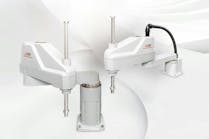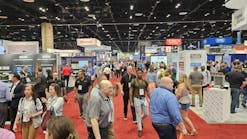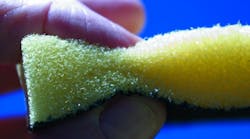In HVAC systems, ducts distribute more than air; they also distribute noise produced by fans. Duct liners (Photo A) were developed in part to absorb noise before it emanates from ductwork. Designers apply different thicknesses and lengths of duct liner to reduce noise to various levels. Understanding the acoustical benefits of duct liners and the available choices in liner materials helps in specifying a system that is efficient and effective, both in terms of noise performance and HVAC performance.
The Buzz on Noise
Sound is a rapidly repeated fluctuation in air pressure. It is energy in motion, kinetic energy in the form of air pressure. If the frequency of change is consistent, we may perceive sound of a particular musical pitch. When pressure changes happen at random frequencies, the sound is called "broadband," which often is perceived as "noise."
The percentage of change in ambient atmospheric pressure needed to create audible sound is small. Pressure fluctuations of less than 3 percent, occurring at a frequency of hundreds or thousands of times per second (audio frequencies), are perceived by the human ear as painfully loud sound.
Fans capable of moving air through an entire building are powerful, generating a significant amount of energy in ductwork, some of it in the form of noise. This energy is distributed throughout the duct system until it is either allowed to escape through openings to the building or absorbed.
Fan noise can create acoustic conditions that are undesirable and unacceptable for many types of occupancy. It might interfere with human speech, for example. However, a low level of background noise often is considered beneficial for ordinary activities, such as those in an office, because it improves speech privacy by interfering with the audibility of more distracting noises, such as a talkative colleague.
Soaking up Noise
Duct liners remove noise energy from ductwork without significantly reducing the overall kinetic energy that has been put into the system to move air. They do this by acting as sound-absorbing surfaces on the inside of air ducts, reducing the transmission of noise. Duct liners take noise energy out of a system by transforming it into another form of energy, usually heat.
There are two basic types of duct liner: fibrous and foam. Fibrous and foam duct liners absorb noise in slightly different ways.
Fibrous liners are made of unconnected, loosely packed glass fibers. As air passes through the bundle, the fibers rub against one another, which produces infinitesimally small amounts of heat. Sound is absorbed through this transformation of kinetic energy into friction.
Polyimide is a flexible open-cell foam. Polyimide-foam liners have a contiguous, as opposed to open, network structure, but behave similarly to fibrous liners in that sound energy enters, is converted to heat, and dissipated.
Elastomeric foam generally is a closed-cell material prohibiting air penetration. Elastomeric-foam liners are made of an expanded cross-linked rubber compound, the cells of which are fully enclosed gas bubbles. Air pressure impacts the surface of the foam, compressing it slightly. In the process, acoustical energy is absorbed.
Figure 1 compares the sound-absorption efficiencies of fiber-glass, polyimide-foam, and elastomeric-foam duct liners. Testing was performed per ASTM C423, Standard Test Method for Sound Absorption and Sound Absorption Coefficients by the Reverberation Room Method.
Sound absorption is directly proportional to exposed surface area and liner thickness. Based on those factors, a designer can compute the length of ductwork that would have to be lined to achieve a given level of noise reduction. For example, consider a project in need of 5 dB of fan-noise attenuation at 250 Hz through 24-in.-by-24-in. ductwork. Using the path-noise estimation methodology presented in Chapter 48 of 2011 ASHRAE Handbook—HVAC Applications,1 approximately 50 ft of unlined sheet-metal ductwork would be needed; alternatively, this attenuation can be provided within a length of only 10 ft of ductwork with 1-in. sound-absorbing internal lining (which achieves a noise-reduction coefficient [NRC] of 0.70 or higher, as measured by ASTM C423).
Internal liners reduce duct cross-sectional area. For that reason, liners usually are kept to a minimum thickness, often 1 in. To illustrate the impact of liner thickness, for an 18-in.-by-24-in. duct, going from a 1-in.-thick liner to a 2-in.-thick liner decreases flow area by about 20 percent, resulting in an increase in air velocity of 26 percent.
Designing Noise Levels
Designing mechanical-system noise levels involves consideration of the following factors:
- The target noise goal.
- Air-handler noise output.
- Liner-material noise-reduction capability—measured as sound-absorption coefficient/NRC or "insertion loss."
- Duct dimensions.
Noise goals depend on the use of a space. An office, apartment, or classroom usually requires a moderate amount of HVAC-noise reduction for normal activities to be accommodated. For these projects, as little as 10 to 20 ft of lined duct, usually immediately adjoining the mechanical room, is all that is needed for noise goals to be met.
Conversely, certain spaces are more sensitive and require low mechanical-noise levels—performance spaces and recording studios are two examples. The ducts of such spaces may need to be lined continuously from one end to the other.
Acousticians establish specific noise goals using a measure called room criterion (RC), the overall background-noise level across the audible frequency range. The RC for a generic office space might be 30 to 35, while for an airport lobby, it might be about 40, and for an extremely quiet concert hall with exacting acoustical demands, it might be less than 15. For this target level to be achieved, all sources of noise, not just the HVAC system, must be considered.
The noise output of air handlers generally is specified by manufacturers per Air Movement and Control Association standards.
The fundamental material properties of a liner determine the liner’s sound-absorption capability. Thicker material absorbs more sound, but also cuts down the cross-section of a duct. One- and 2-in. thicknesses are standard. Surface area—and, therefore, noise reduction—is increased by lining more linear feet of a duct.
There are two commonly used measures of the noise-reduction efficacy of liner materials. In both cases, a material's ability to reduce noise is measured in several frequency ranges, called octave bands. (Doubling the frequency of a sound raises its pitch by one octave.) The standard octave bands are centered on the frequencies 63 Hz, 125 Hz, 250 Hz, 500 Hz, 1,000 Hz, 2,000 Hz, 4,000 Hz, and 8,000 Hz. Human hearing sensitivity falls off sharply above and below this range.
Sound-absorption coefficients, which represent the percentage of sound energy absorbed by a material, are measured using ASTM C423. The material is mounted in a specified manner, and its ability to absorb sound is measured in the four octave bands in which most human speech falls: 250 Hz, 500 Hz, 1,000 Hz, and 2,000 Hz. The average of these four coefficients is the NRC.
When selecting sound-absorbing materials, it is important to compare performance in specific octave-band frequencies, rather than rely merely on NRC. This is because some materials absorb sound much better in the higher frequencies, resulting in a high NRC that may not accurately reflect performance in all octave bands.
Insertion loss is a measure of the extent to which noise is reduced with the addition of sound-absorbing material to a duct system. It is tested using ASTM E477, Standard Test Method for Measuring Acoustical and Airflow Performance of Duct Liner Materials and Prefabricated Silencers. The test introduces 10 ft of lined duct between a noise-source room and a reverberating room, where the noise is measured. The insertion loss provided by internal duct lining generally is reported for each of the eight octave bands and measured by the decibels of sound reduced per foot of duct for straight duct or elbows in a variety of common duct sizes. Because sound absorption depends on surface area, the perimeter of the duct, not its cross-sectional area, determines the insertion loss that is achieved. For example, a 24-in.-by-24-in. duct with 4-sq-ft cross section has 8 sq ft of liner surface per foot of duct, while a 12-in.-by-48-in. duct with a 4-sq-ft cross section has 10 sq ft of liner surface per foot of duct—25-percent more sound-absorption capability.
While designers typically seek to engineer ductwork systems based on the insertion-loss performance of lining material, manufacturers of many duct-liner products provide only sound-absorption data and the resultant NRC, not insertion-loss data. This leaves the designer to make assumptions as to whether the data are comparable to published insertion-loss data for other duct-lining products.
Sound-absorption and insertion-loss values are well-established for the common thicknesses of glass-fiber lining. As a result, glass-fiber lining has become the standard designers use in analyzing lining systems. Designers can compare sound-absorption data of alternative products to those of glass fiber and extrapolate from known glass-fiber insertion-loss figures to specify alternative-liner length and thickness.
Non-fibrous liners have come into prominence of late because of reluctance on some owners’ part to use fibrous materials. This reluctance stems from health concerns, although the science on health impacts is conflicting.
Sound attenuators can be placed in a ductwork system to reduce fan noise. These devices use sound-absorbing materials installed behind perforated metal and exposed to airflow. Because sound attenuators tend to create obstructions, liners may be preferred to minimize airflow restriction and the energy use of fans, unless significant low-frequency-noise reduction is required.
Other Noise
Noise and vibration from an air handler also can be transmitted through metal ductwork. To prevent this, a short section of fabric duct, called a flexible connection, sometimes is inserted at an air handler to break the mechanical continuity of the ductwork from the rest of the system.
Another potential concern with ductwork systems is "crosstalk"—sound moving between rooms. It is most common where two rooms are served by a single main duct that splits near the outlets and most significant where ductwork consists of bare sheet metal. Crosstalk is both a noise-control issue and a speech-privacy problem. It can be avoided by lining ducts between rooms.
Summary
Duct liners can absorb HVAC sound energy, resolve noise problems, and improve occupant satisfaction and comfort, all the while providing thermal insulation. A mechanical engineer can design an effective system using published performance data, although complex structures or demanding acoustic requirements may warrant the employment of an acoustic specialist.
Reference
1) ASHRAE. (2011). ASHRAE handbook—HVAC applications. Atlanta: American Society of Heating, Refrigerating and Air-Conditioning Engineers.
Stephanie Ayers is marketing manager for Evonik Foams Inc., maker of polyimide-foam products. She is a 15-year insulation-industry veteran and a member of the American Society of Heating, Refrigerating and Air-Conditioning Engineers; the National Insulation Association; and the National Fire Protection Association. Jeffrey L. Fullerton, INCE Bd. Cert., LEED AP BD+C, is a supervisory consultant for Acentech Inc., a multidisciplinary consulting firm comprised of acoustical consultants, audiovisual consultants, noise and vibration consultants, information-technology consultants, and more. He works on a wide range of architectural acoustic and mechanical-system noise- and vibration-control projects. Steven H. Miller, CDT, is an award-winning writer and photographer specializing in construction-industry issues. He is creative director for Chusid Associates, a technical and marketing consulting firm serving building-product manufacturers.
Did you find this article useful? Send comments and suggestions to Executive Editor Scott Arnold at [email protected].









